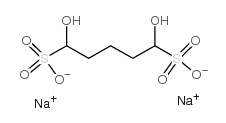Sodium glutaraldehyde bisulfite
Modify Date: 2025-08-21 10:46:22

Sodium glutaraldehyde bisulfite structure
|
Common Name | Sodium glutaraldehyde bisulfite | ||
|---|---|---|---|---|
| CAS Number | 28959-35-5 | Molecular Weight | 308.23800 | |
| Density | N/A | Boiling Point | N/A | |
| Molecular Formula | C5H10Na2O8S2 | Melting Point | >300ºC(lit.) | |
| MSDS | N/A | Flash Point | N/A | |
| Name | glutaraldehyde sodium bisulfite addition compound |
|---|---|
| Synonym | More Synonyms |
| Melting Point | >300ºC(lit.) |
|---|---|
| Molecular Formula | C5H10Na2O8S2 |
| Molecular Weight | 308.23800 |
| Exact Mass | 307.96100 |
| PSA | 171.62000 |
| LogP | 0.04550 |
Synonym: Section 2 - COMPOSITION, INFORMATION ON INGREDIENTS
Risk Phrases: None Listed. Section 3 - HAZARDS IDENTIFICATION EMERGENCY OVERVIEW
The toxicological properties of this material have not been fully investigated. Potential Health Effects Eye: May cause eye irritation. Skin: May cause skin irritation. Ingestion: The toxicological properties of this substance have not been fully investigated. Inhalation: May cause respiratory tract irritation. Chronic: Not available. Section 4 - FIRST AID MEASURES Eyes: Flush eyes with plenty of water for at least 15 minutes, occasionally lifting the upper and lower eyelids. Get medical aid. Skin: Get medical aid. Flush skin with plenty of water for at least 15 minutes while removing contaminated clothing and shoes. Ingestion: Get medical aid. Wash mouth out with water. Inhalation: Remove from exposure and move to fresh air immediately. If not breathing, give artificial respiration. If breathing is difficult, give oxygen. Get medical aid. Notes to Physician: Section 5 - FIRE FIGHTING MEASURES General Information: As in any fire, wear a self-contained breathing apparatus in pressure-demand, MSHA/NIOSH (approved or equivalent), and full protective gear. Extinguishing Media: Use water spray, dry chemical, carbon dioxide, or chemical foam. Section 6 - ACCIDENTAL RELEASE MEASURES General Information: Use proper personal protective equipment as indicated in Section 8. Spills/Leaks: Vacuum or sweep up material and place into a suitable disposal container. Section 7 - HANDLING and STORAGE Handling: Avoid breathing dust, vapor, mist, or gas. Avoid contact with skin and eyes. Storage: Store in a cool, dry place. Store in a tightly closed container. Section 8 - EXPOSURE CONTROLS, PERSONAL PROTECTION Engineering Controls: Use adequate ventilation to keep airborne concentrations low. Exposure Limits CAS# 28959-35-5: Personal Protective Equipment Eyes: Wear appropriate protective eyeglasses or chemical safety goggles as described by OSHA's eye and face protection regulations in 29 CFR 1910.133 or European Standard EN166. Skin: Wear appropriate protective gloves to prevent skin exposure. Clothing: Wear appropriate protective clothing to minimize contact with skin. Respirators: Follow the OSHA respirator regulations found in 29 CFR 1910.134 or European Standard EN 149. Use a NIOSH/MSHA or European Standard EN 149 approved respirator if exposure limits are exceeded or if irritation or other symptoms are experienced. Section 9 - PHYSICAL AND CHEMICAL PROPERTIES Physical State: Solid Color: white to off-white Odor: Odorless pH: Not available. Vapor Pressure: Not available. Viscosity: Not available. Boiling Point: Not available. Freezing/Melting Point: > 300 deg C Autoignition Temperature: Not available. Flash Point: Not available. Explosion Limits, lower: Not available. Explosion Limits, upper: Not available. Decomposition Temperature: Solubility in water: Specific Gravity/Density: Molecular Formula: C5H10O8S2Na2 Molecular Weight: 308.22 Section 10 - STABILITY AND REACTIVITY Chemical Stability: Not available. Conditions to Avoid: Incompatible materials. Incompatibilities with Other Materials: Strong oxidizing agents, strong acids. Hazardous Decomposition Products: Carbon monoxide, oxides of sulfur, carbon dioxide. Hazardous Polymerization: Has not been reported Section 11 - TOXICOLOGICAL INFORMATION RTECS#: CAS# 28959-35-5 unlisted. LD50/LC50: Not available. Carcinogenicity: Glutaraldehyde sodium bisulfite addition compound - Not listed by ACGIH, IARC, or NTP. Section 12 - ECOLOGICAL INFORMATION Section 13 - DISPOSAL CONSIDERATIONS Dispose of in a manner consistent with federal, state, and local regulations. Section 14 - TRANSPORT INFORMATION IATA Not regulated as a hazardous material. IMO Not regulated as a hazardous material. RID/ADR Not regulated as a hazardous material. Section 15 - REGULATORY INFORMATION European/International Regulations European Labeling in Accordance with EC Directives Hazard Symbols: Not available. Risk Phrases: Safety Phrases: S 24/25 Avoid contact with skin and eyes. WGK (Water Danger/Protection) CAS# 28959-35-5: No information available. Canada None of the chemicals in this product are listed on the DSL/NDSL list. CAS# 28959-35-5 is not listed on Canada's Ingredient Disclosure List. US FEDERAL TSCA CAS# 28959-35-5 is not listed on the TSCA inventory. It is for research and development use only. SECTION 16 - ADDITIONAL INFORMATION N/A |
| Safety Phrases | S24/25 |
|---|
| Einecs 249-339-8 |
| Glutaraldehydebis(sodiumhydrogensulfite) |
| GLUTARALDEHYDE BIS SODIUM BISULFITE |
| disodium 1,5-dihydroxypentane-1,5-disulphonate |
| MFCD00007517 |
| GLUTARALDEHYDE SODIUM BISULPHITE ADDITION COMPOUND |
| Sodium glutaraldehyde bisulfite |
| Glutaraldehyde sodium bisulphite |
| GLUTARALDEHYDE SODIUM HYDROGENULFITE |
| Pentanedial/sulfurous acid sodium,(1:x) salt |
| GLUTARALDEHYDE SODIUM BISULFITE |